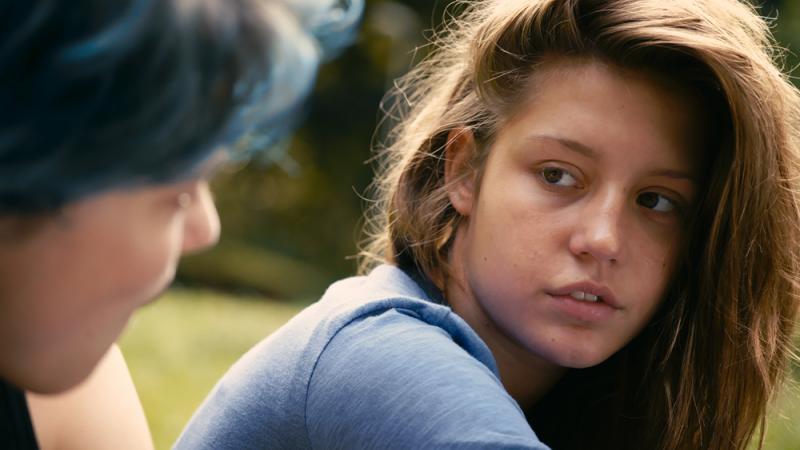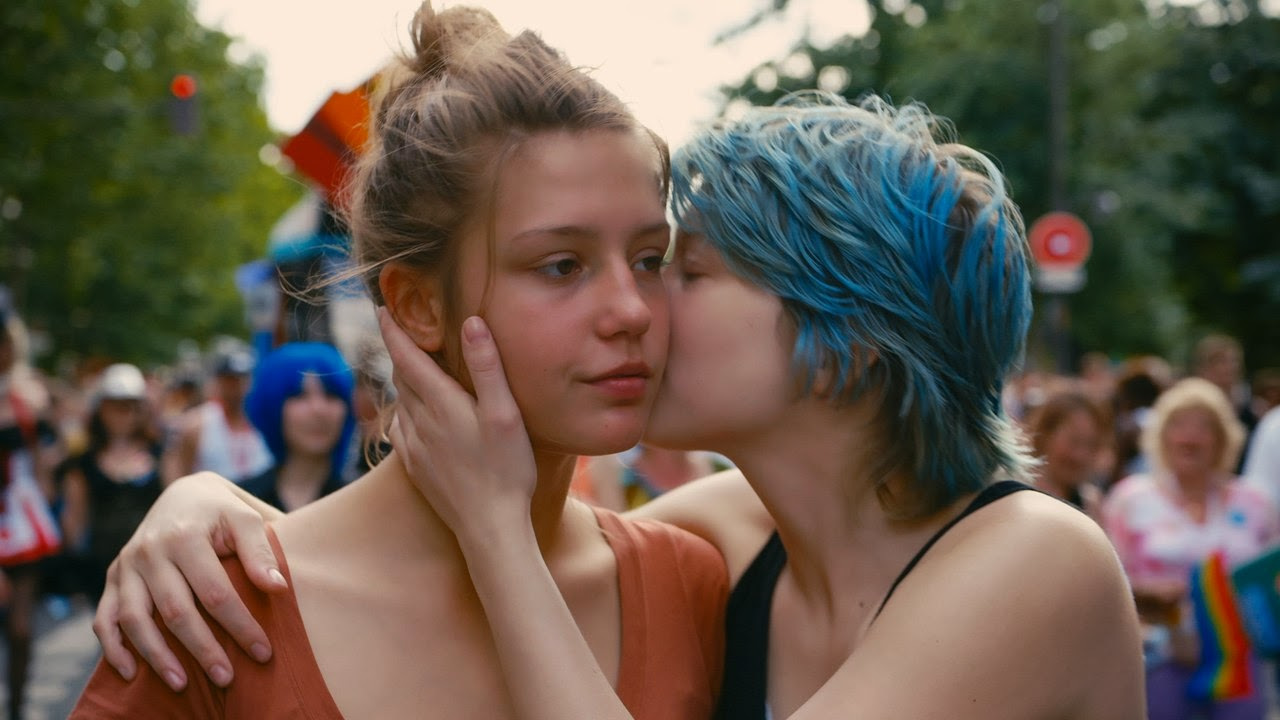Blue Is the Warmest Colour | reviews, news & interviews
Blue Is the Warmest Colour
Blue Is the Warmest Colour
Adèle Exarchopoulos shines in electric, emotionally raw Palme d'Or winner

“The most potent special effect in movies is the human face changing its mind.” So stated film critic David Thomson, and the principle has never been more irrefutably proven than by Blue Is the Warmest Colour and its leading lady Adèle Exarchopoulos. The electric, emotionally raw story of 15-year-old schoolgirl Adèle’s sexual awakening unfolds in a series of languid close-ups and unbroken takes, and her face is centre-stage throughout, captivating both in its moments of beauty and ugliness, continually on the brink of change.
Director Abdellatif Kechiche, whose treatment of his cast and crew has sparked the kind of controversy that unfortunately threatens to eclipse all that is good about the film, exhibits an almost clinical fascination with Exarchopoulos, who for her part gives a performance so vivid and vulnerable that at times you feel winded watching her.
Despite the inevitable attention that has been drawn by the film’s expansive sapphic love scenes, it’s generally closer to a character study than a love story; from the very first shots of Adèle leaving her parents’ house in the suburbs, boarding a bus and commuting to her school in central Lille, an almost anthropological intimacy is established in our view of her. We see her learning, walking, sleeping, eating, dancing, teaching, talking, often in snatches rather than complete A-to-B scenes, and when we do see her having sex it’s in the same matter-of-fact detail as everything else.
 The graphic novel from which Kechiche and Ghalia Lacroix’s script is titled Blue Angel, in reference to Léa Seydoux’s worldly art student Emma, who becomes Adèle’s first real love and first real loss. Prior to their meeting she has an ill-fated fling with a male fellow student, and predictable though this is as a plot element, the crushing sense of erotic disillusionment that Exarchopoulos conveys in the aftermath is painfully immediate.
The graphic novel from which Kechiche and Ghalia Lacroix’s script is titled Blue Angel, in reference to Léa Seydoux’s worldly art student Emma, who becomes Adèle’s first real love and first real loss. Prior to their meeting she has an ill-fated fling with a male fellow student, and predictable though this is as a plot element, the crushing sense of erotic disillusionment that Exarchopoulos conveys in the aftermath is painfully immediate.
It’s more telling, in fact, than most of the lovemaking she shares with Emma, which unfolds in self-consciously lengthy single takes that feel anatomical rather than illustrative; they tell us little about the couple, their relationship or the momentous passion between them. This we discover in other, less showy moments: they share the kind of conversations about art, literature and career ambitions that are too often overlooked by screenwriters, and when the emotional storm clouds start to gather, it’s clear exactly how much both have to lose.
Blue Is the Warmest Colour made Cannes history this year, becoming the first film to be awarded a shared Palme d’Or for its director and two leading actresses. While the trifecta has plainly not been a harmonious one, what they have produced is a rare thing: a passionate, wrenching and genuinely complete portrait of a human being in flux.
Overleaf: watch the trailer to Blue Is The Warmest Colour
“The most potent special effect in movies is the human face changing its mind.” So stated film critic David Thomson, and the principle has never been more irrefutably proven than by Blue Is the Warmest Colour and its leading lady Adèle Exarchopoulos. The electric, emotionally raw story of 15-year-old schoolgirl Adèle’s sexual awakening unfolds in a series of languid close-ups and unbroken takes, and her face is centre-stage throughout, captivating both in its moments of beauty and ugliness, continually on the brink of change.
Director Abdellatif Kechiche, whose treatment of his cast and crew has sparked the kind of controversy that unfortunately threatens to eclipse all that is good about the film, exhibits an almost clinical fascination with Exarchopoulos, who for her part gives a performance so vivid and vulnerable that at times you feel winded watching her.
Despite the inevitable attention that has been drawn by the film’s expansive sapphic love scenes, it’s generally closer to a character study than a love story; from the very first shots of Adèle leaving her parents’ house in the suburbs, boarding a bus and commuting to her school in central Lille, an almost anthropological intimacy is established in our view of her. We see her learning, walking, sleeping, eating, dancing, teaching, talking, often in snatches rather than complete A-to-B scenes, and when we do see her having sex it’s in the same matter-of-fact detail as everything else.
 The graphic novel from which Kechiche and Ghalia Lacroix’s script is titled Blue Angel, in reference to Léa Seydoux’s worldly art student Emma, who becomes Adèle’s first real love and first real loss. Prior to their meeting she has an ill-fated fling with a male fellow student, and predictable though this is as a plot element, the crushing sense of erotic disillusionment that Exarchopoulos conveys in the aftermath is painfully immediate.
The graphic novel from which Kechiche and Ghalia Lacroix’s script is titled Blue Angel, in reference to Léa Seydoux’s worldly art student Emma, who becomes Adèle’s first real love and first real loss. Prior to their meeting she has an ill-fated fling with a male fellow student, and predictable though this is as a plot element, the crushing sense of erotic disillusionment that Exarchopoulos conveys in the aftermath is painfully immediate.
It’s more telling, in fact, than most of the lovemaking she shares with Emma, which unfolds in self-consciously lengthy single takes that feel anatomical rather than illustrative; they tell us little about the couple, their relationship or the momentous passion between them. This we discover in other, less showy moments: they share the kind of conversations about art, literature and career ambitions that are too often overlooked by screenwriters, and when the emotional storm clouds start to gather, it’s clear exactly how much both have to lose.
Blue Is the Warmest Colour made Cannes history this year, becoming the first film to be awarded a shared Palme d’Or for its director and two leading actresses. While the trifecta has plainly not been a harmonious one, what they have produced is a rare thing: a passionate, wrenching and genuinely complete portrait of a human being in flux.
Overleaf: watch the trailer to Blue Is The Warmest Colour
The future of Arts Journalism
You can stop theartsdesk.com closing!
We urgently need financing to survive. Our fundraising drive has thus far raised £49,000 but we need to reach £100,000 or we will be forced to close. Please contribute here: https://gofund.me/c3f6033d
And if you can forward this information to anyone who might assist, we’d be grateful.

Subscribe to theartsdesk.com
Thank you for continuing to read our work on theartsdesk.com. For unlimited access to every article in its entirety, including our archive of more than 15,000 pieces, we're asking for £5 per month or £40 per year. We feel it's a very good deal, and hope you do too.
To take a subscription now simply click here.
And if you're looking for that extra gift for a friend or family member, why not treat them to a theartsdesk.com gift subscription?
more Film
 Train Dreams review - one man's odyssey into the American Century
Clint Bentley creates a mini history of cultural change through the life of a logger in Idaho
Train Dreams review - one man's odyssey into the American Century
Clint Bentley creates a mini history of cultural change through the life of a logger in Idaho
 Palestine 36 review - memories of a nation
Director Annemarie Jacir draws timely lessons from a forgotten Arab revolt
Palestine 36 review - memories of a nation
Director Annemarie Jacir draws timely lessons from a forgotten Arab revolt
 Die My Love review - good lovin' gone bad
A magnetic Jennifer Lawrence dominates Lynne Ramsay's dark psychological drama
Die My Love review - good lovin' gone bad
A magnetic Jennifer Lawrence dominates Lynne Ramsay's dark psychological drama
 Bugonia review - Yorgos Lanthimos on aliens, bees and conspiracy theories
Emma Stone and Jesse Plemons excel in a marvellously deranged black comedy
Bugonia review - Yorgos Lanthimos on aliens, bees and conspiracy theories
Emma Stone and Jesse Plemons excel in a marvellously deranged black comedy
 theartsdesk Q&A: director Kelly Reichardt on 'The Mastermind' and reliving the 1970s
The independent filmmaker discusses her intimate heist movie
theartsdesk Q&A: director Kelly Reichardt on 'The Mastermind' and reliving the 1970s
The independent filmmaker discusses her intimate heist movie
 Blu-ray: Wendy and Lucy
Down-and-out in rural Oregon: Kelly Reichardt's third feature packs a huge punch
Blu-ray: Wendy and Lucy
Down-and-out in rural Oregon: Kelly Reichardt's third feature packs a huge punch
 The Mastermind review - another slim but nourishing slice of Americana from Kelly Reichardt
Josh O'Connor is perfect casting as a cocky middle-class American adrift in the 1970s
The Mastermind review - another slim but nourishing slice of Americana from Kelly Reichardt
Josh O'Connor is perfect casting as a cocky middle-class American adrift in the 1970s
 Springsteen: Deliver Me From Nowhere review - the story of the Boss who isn't boss of his own head
A brooding trip on the Bruce Springsteen highway of hard knocks
Springsteen: Deliver Me From Nowhere review - the story of the Boss who isn't boss of his own head
A brooding trip on the Bruce Springsteen highway of hard knocks
 The Perfect Neighbor, Netflix review - Florida found-footage documentary is a harrowing watch
Sundance winner chronicles a death that should have been prevented
The Perfect Neighbor, Netflix review - Florida found-footage documentary is a harrowing watch
Sundance winner chronicles a death that should have been prevented
 Blu-ray: Le Quai des Brumes
Love twinkles in the gloom of Marcel Carné’s fogbound French poetic realist classic
Blu-ray: Le Quai des Brumes
Love twinkles in the gloom of Marcel Carné’s fogbound French poetic realist classic
 Frankenstein review - the Prometheus of the charnel house
Guillermo del Toro is fitfully inspired, but often lost in long-held ambitions
Frankenstein review - the Prometheus of the charnel house
Guillermo del Toro is fitfully inspired, but often lost in long-held ambitions
 London Film Festival 2025 - a Korean masterclass in black comedy and a Camus classic effectively realised
New films from Park Chan-wook, Gianfranco Rosi, François Ozon, Ildikó Enyedi and more
London Film Festival 2025 - a Korean masterclass in black comedy and a Camus classic effectively realised
New films from Park Chan-wook, Gianfranco Rosi, François Ozon, Ildikó Enyedi and more

Add comment